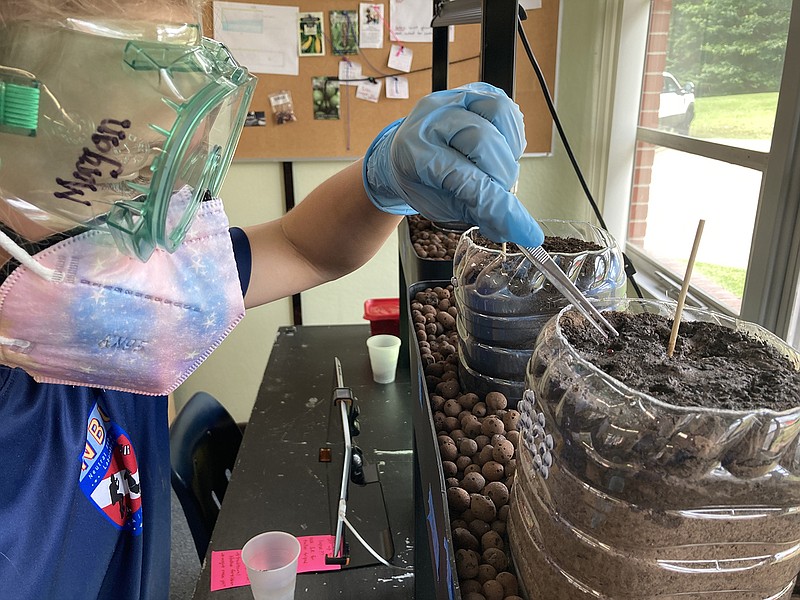TEXARKANA, Texas - Students at St. James Day School had such a good time growing on the Moon, they took it as this past summer's mission to make life for Mars.
And they found success on Mars - or rather on a simulated Martian regolith, similar to soil - with agricultural strategies used by Native Americans.
Participating in the Plant the Moon and Plant Mars programs hosted by both the Institute of Competition Sciences in partnership with the University of Central Florida's CLASS Exolith Laboratory and NASA Solar System Exploration Research Virtual Institute, the St. James team planted edible crops as part of an international research challenge.
The St. James 7th and 8th grade students were so successful in their Mars mission that NASA scientists and university researchers recognized them with with two "Best in Show" awards at the end of August: "Best Evaluation of Results and "Best Experimental Design."
Their Plant the Moon project also won recognition last season in the spring, so it's no surprise their motto is "Grow big or go home!" They can grow big.
Specifically, the St. James students grew squash, beans and corn together, a planting method taught to colonial farmers by Native Americans to make what's called a Three Sisters garden, explained St. James teacher Nicole Ayers who worked with the students.
"We received a shipment of simulated Mars soil, so it's made to match the chemical and physical properties of what they expect the ground would be like on Mars. We have the choice between Mars and the Moon for this competition, and since we had done Moon soil with the last one the kids wanted to do Mars," Ayers said.
Toward the end of the school year and into the summer, students designed their experiment around something they'd like to study."We decided that we wanted to look at how the early colonial farmers learned to plant corn, beans and squash together in a Three Sisters garden, and we wanted to try that in Martian simulant," Ayers said.
They planted some of those crops together, some separately, with both the simulant and separately with potting soil to check that the setup was conducive to growing those plants.
"In our research we had actually come across a quote from Buzz Aldrin, and it was basically saying that in the future when settlers go to Mars they're not going to come back, just in the same way that the early settlers came from Europe to the Americas they didn't come with the mindset of, I'm going to go on vacation and go back to where I came from," Ayers said. They were going to stay.
Looking at the past and future made for an interesting juxtaposition. How did those settlers learn to survive, they wondered?
"The more we dug into it we learned the importance of the indigenous peoples who were already there teaching them what plants would grow best in the type of soil they were learning to farm," Ayers said. "And also the harmony between the different plants."
Each crop - corn, beans, squash - had a role and a certain purpose growing together rather than in isolation.
Students participating were Daniel Ayers, Katherine Ayers, Addison Bobo, Staten Crossland, Rosie Jordan, Cooper Kimmel, Olivia Kimmel, John O'Donnell, Abigail Thomson and Morgan Yost.
"We had really good success with the corn. In fact the corn is still growing even though the experiment ended. It's literally touching the ceiling. The kids had to climb on the tables and stretch out as tall as they could to measure how tall the plants were," Ayers said. "Also, toward the very end of the experiment, the corn moved from the vegetative state to the reproductive state where it started developing tassels and small ears with silk."
They didn't know much about corn before, but they got an education in it through the project.
"We have ears of corn in our science lab that's growing in Martian soil, which is really exciting," the teacher said.
On the other hand, beans and squash failed to germinate. They have theories on why the corn was successful, and the students may research further with independent projects. One student wants to study the difference between monocots (one leaf) and dicots (two leaves).
"They also have different root systems, and we think that that could possibly have something to do with it," Ayers said.
They're also looking more closely at the Mars soil itself, which includes magnesium sulfate. It's possible there's too much of that for the plants they tried to grow, she suspects, based on other research they found. The simulants come from that Exolith lab.
The regoliths are the rocky component of soil, she explained, as true soil has sand, clay and organic matter, such as trees and animals that decayed. Their simulants are crushed rock, a sterile substance.
They used aquaponics to water the plants. That meant fish grew in the water with the fish waste in the water used as a natural fertilizer, the plants purifying the water to bring it back into the system, she said. There's harmony that way.
"The challenge, and basically NASA is crowdsourcing research here, is to find out what's the easiest way to basically add the minimum amount to crushed rock to be able to grow things," Ayers said. There's a lot we take for granted when we drop seeds in a pot of Miracle-Gro, she said.
The practical application comes with the Artemis mission to establish a presence on the Moon. After that, it's on to Mars.
"Its' definitely a push for NASA to figure out how do we, in the least expensive way possible, grow our own food," Ayers said.
And for Ayers, what's exciting is that she can work with middle school students to conduct authentic research that may make a difference to scientists trying to establish a human presence on the Moon and then Mars. Her students were excited, but they have their eyes set on another award with plant growth.
To that end, they'll participate in the fall season by growing sunflowers, the "Fourth Sister" in the Native American tradition, she said.
"They're pretty inspired to try again and grow really big plants," Ayers said.
(On the Net: Plantthemoon.com.)




